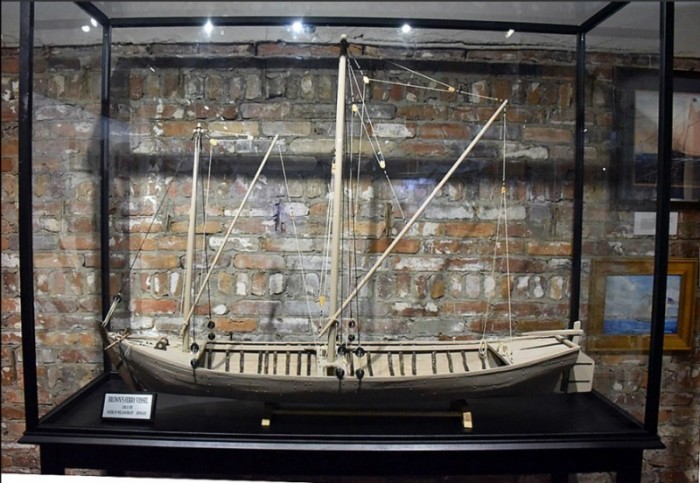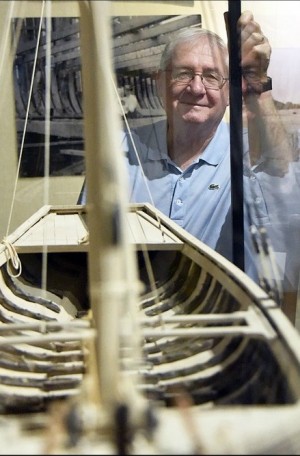Brown’s Ferry Vessel: After 275 years, second thoughts about historic boat
By Jason Lesley for the Coastal Observer with photos by Tanya Ackerman
Archaeologists who worked to raise the Brown’s Ferry Vessel from the Black River and display it at the Rice Museum in Georgetown admit it now: Their model is not accurate.
The cargo ship had a transom and an aft deck that was overlooked until experts reassembled its remains on the third floor of the Rice Museum in 1992 and changed their opinion of how the vessel looked.
A new model of the oldest commercial vessel recovered in the southeastern United States will go on public display Saturday at the South Carolina Maritime Museum on Front Street, Georgetown.

William Brady of Litchfield Country Club built the model using plans drawn by yacht designer Ed Scott of Georgetown. Brady, Scott and museum board member Mac McAlister began talking about building a new model of the Brown’s Ferry Vessel more than a year ago. Their meeting at the Rice Museum to look over the vessel’s hull proved to be a confluence of unique talents.
Scott, formerly director of the boat school in Eastport, Maine, and his wife, Pat, had recently moved to Georgetown when the school closed. Brady, an Air Force retiree and model builder, moved to Litchfield with his wife, Yolanda, just a few years ago. McAlister and his wife, Mary, settled in McClellanville after sailing the world’s oceans. All have an interest in history and were intrigued by the challenge of bringing a display of Brown’s Ferry Vessel to the museum.
The Brown’s Ferry Vessel sank in the 18th century in Black River carrying 25 tons of bricks made on a plantation. Artifacts, including green glass English wine bottles, oars, millstones, iron pots, a straight razor and smoking pipes made of gourds, enabled historians to date the time of its sinking to between 1730 and 1740. This period is about 50 years earlier than previous American shipbuilding discoveries, and in 1979 the late Richard Steffy of the Institute of Nautical Archaeology at Texas A&M said it was, “the most important single nautical discovery in the United States to date.”
Steffy made a model of the vessel, showing it as double-ended. When his protege, Frederick Hocker, came to Georgetown to view the reassembling of the wooden ship after it had spent 20 years in water and anti-freeze being preserved, he saw that Steffy had misinterpreted the stern because so much of it was missing.
Hocker was a boatbuilder from Mystic Seaport, Conn., and had experience that Steffy did not, Scott said. When Hocker explained his findings, Steffy agreed. When Scott found Hocker’s drawings of the ship with a transom, he e-mailed him at the maritime museum in Stockholm and they discussed theories. Because the ship had a windlass, Scott knew it had a forward deck. He drew a detailed set of full-sized plans for the 50-foot ship and turned them over to Brady.

Brady spent 350 hours building the 1/10 scale model from the same wood as the original: oak, cypress and pine. The size, he said, made this his most ambitious project ever. The original ship had a wide flat bottom that let it slide onto banks where there were no wharves or piers in the early 1700s.
Because the original ship was constructed of thick boards, the scale model presented a challenge. Brady said he soaked the cap rails in water for four days so he could bend them into shape.
The vessel contained a lot of nails, and Brady made his own using upholstery tacks. He made the blocks, anchors, windlass and dead eyes from wood. He made everything except the anchor chains and the rigging cordage.
An amateur diver, Hampton Shuping, discovered the ship in 20 feet of water under the mud near the Brown’s Ferry landing in 1973. The wreck was lying at an angle against the bank, evenly spaced pieces of wood sticking out of the mud, he said. He found a quadrant used for ocean navigating and dug up wine bottles, cups and bowls.
State archeologists showed no interest in the find until 1976.
Ralph Wilbanks of the state Institute of Archaeology and Anthropology spent six weeks preparing the wreck for removal from the Black River. He said it was a seat-of-the-pants operation. “I slept in my van,” he said. Divers used milk crates to bring up the 10,000 bricks that were on top of the vessel and in the mud. Inmates took them to the county prison farm for storage. Wilbanks said he was advised to chop the ship up and raise it in pieces. “No,” he said, “we’re bringing it up whole.”
He borrowed a crane from International Paper and fashioned a lift using tie-down straps from the Charleston Air Force Base.“We were too dumb to know it couldn’t be done,” he said.
Thousands of Georgetown County residents came to watch and word traveled around the world. Wilbanks ordered a nozzle from Camden, N.J. It was delivered with the address: “where they are raising the old boat near Georgetown, S.C.”
There were 8,000 people on the banks of the Black River when the ship was raised out of the water. They sang “Shall We Gather By The River” while they waited, Wilbanks said. The ship was lifted onto a flatbed tractor trailer and hauled to Front Street in Georgetown. Sprinkers kept the wood wet while it was on display.
Wilbanks drove it to Columbia, stopping every 10 miles or so to ask a gas station attendant if he could borrow his hose pipe. Eventually, the ship was placed in water to prevent further deterioration.
From 1977 to 1983 it was maintained in a farm pond before being moved to the Institute of Archaeology and Anthropology at the University of South Carolina. The vessel’s woods were conserved by slowly replacing the water in the wood cells with polyethylene glycol, a process that took more than nine years. In 1992 it was moved to the Rice Museum in Georgetown.
